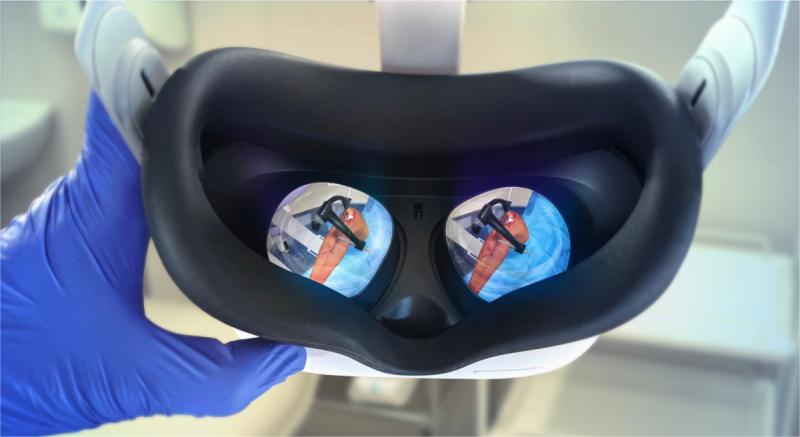
Osso Health brings realistic surgical training to the Vision Pro, allowing complex surgical procedures to be practiced in a safe environment.
Osso VR has introduced the Osso Health app specifically designed for Apple’s Vision Pro mixed reality headset. This release aims to make Osso VR’s technology more accessible to a wider range of individuals, such as healthcare practitioners, patients getting ready for surgical procedures, and individuals with a keen interest in medical advancements.
The application accurately replicates medical procedures and effortlessly incorporates the operating room into the real world setting. It allows for practical, on-demand learning regardless of location.
Using the user’s eyes, hands, and voice, the new three-dimensional user interface and input methods enable easy navigation of the processes. Presently, Osso Health offers the option to guide users through two typical orthopedic procedures: carpal tunnel release and knee replacement.
VR Training for future doctors
Osso VR is a company specializing in VR training for future doctors, co-founded in 2016 by orthopedic surgeon Justin Barad. The platform is characterized by high graphic realism and works with specialists from the film and video game industry.
Osso VR’s VR training courses are used in over twenty international hospitals and by eight medical device manufacturers, including pharmaceutical and medical device companies such as Johnson & Johnson, Stryker, Zimmer Biomet and Smith & Nephew.
In early April, Osso VR and the ACC announced a new VR training program specifically for cardiologists. The company has secured $109 million in funding to date and aims to use VR training to address the lack of standards in surgeon training.
Integrating Apple Vision Pro with Osso VR
The integration of Apple Vision Pro with Osso VR brings numerous benefits to surgical training. The Vision Pro’s advanced VR capabilities such as precise tracking, wide field of view, and high-definition visuals, enhance the realism of Osso VR’s simulations. This synergy allows for a more immersive training experience that can mimic the complexities of actual surgical environments.
Detailed Simulations: With Apple Vision Pro, Osso VR can create detailed, realistic simulations of surgical procedures. The headset’s powerful processing capabilities allow for the rendering of intricate textures and complex anatomical structures, providing users with a visual fidelity that closely resembles real-life conditions.
Haptic Feedback: One of the standout features of Apple Vision Pro is its sophisticated haptic feedback system. In surgical training, this allows trainees to ‘feel’ the procedure. When combined with Osso VR’s educational content, this feature helps to instill a deeper understanding of tactile responses during various surgical procedures.
Interactivity and User Engagement: The Apple Vision Pro offers enhanced interactivity, which is crucial for engaging users in long training sessions. Its intuitive controls and ergonomic design reduce the learning curve for operating the headset, allowing surgeons to focus more on the intricacies of the surgical procedures they are learning.
The Educational Impact of VR in Surgical Training
Increased Accessibility: One of the most significant benefits of using VR in surgical training is increased accessibility. With Apple Vision Pro and Osso VR, institutions can offer training without the need for physical presence in a lab or access to often scarce and expensive resources like cadavers or specialized medical equipment.
Enhanced Learning Retention: VR has been shown to improve retention rates significantly over traditional learning methods. The immersive experience provided by VR stimulates multiple senses, which can enhance memory and recall. For surgical training, this means procedures can be learned and remembered more quickly and with greater accuracy.
Scalability and Customization: Osso VR’s platform, when used with Apple Vision Pro, allows for the scalability of training programs. Institutions can customize the training modules based on specific educational needs or surgical specialties. This flexibility ensures that learning is always aligned with the latest surgical standards and techniques.
Real-world Application and Case Studies
Several institutions have already begun incorporating Apple Vision Pro and Osso VR into their curriculums. For example, a leading medical university in the United States reported a 30% improvement in surgical accuracy among students trained using VR technology compared to those who underwent traditional training. Another case study from a European surgical center highlighted how VR training could reduce the time required for surgeons to become proficient in specific complex procedures.
Challenges and Future Directions
Despite the promising benefits, the integration of VR into surgical training faces several challenges. The high cost of advanced VR equipment like Apple Vision Pro can be a barrier for many institutions. Additionally, there is a need for ongoing content development to keep up with the rapid advancements in surgical techniques.
Looking ahead, the future of surgical training with platforms like Osso VR and devices like Apple Vision Pro appears bright. Continued technological advancements and increasing adoption of VR will likely make this method of training a standard in medical education. Further research and development will enhance the effectiveness, realism, and accessibility of VR surgical simulations, ultimately leading to better training, safer surgeries, and improved patient outcomes.
Conclusion:
The collaboration between Apple Vision Pro and Osso VR represents a groundbreaking advancement in medical training technology. By combining cutting-edge VR hardware with comprehensive, realistic simulation software, this partnership is setting new standards in how surgical professionals are trained. As this technology continues to evolve and become more integrated into medical training programs worldwide, it holds the promise of creating highly skilled surgical professionals equipped to meet the demands of modern medicine.







